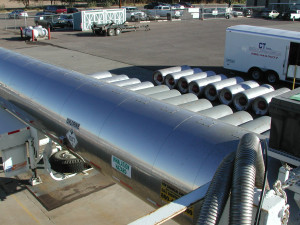At 11.30 am., a chlorine gas release led to the evacuation over 259 ha including 2,500 homes (7,200 residents), and several businesses. An elementary school and a hospital were ordered to shelter-in-place. Five residents and 11 police officers sought medical attention for symptoms of chlorine exposure.
The company repackages chlorine from railcars into smaller containers. The chlorine vented from these operations is captured in one of two scrubbers filled with caustic soda (NaOH at 21 %), producing household bleach (NaOCl) as a by-product. The scrubbers are 15 m3, fibreglass reinforced plastic tanks. They operate as batch chemical reactors, with one unit receiving chlorine, and the other operating as a backup. Chlorine vented from repackaging operations is fed to the scrubber until the caustic concentration reaches 0.2-0.5 percent, as required by customer specifications for bleach. A batch of bleach is considered complete when laboratory (off-line) analysis of the scrubber solution confirms the bleach solution meets customer specifications. The chlorine flow is then manually switched to the standby unit. Two oxidation reduction potential (ORP) meters located in the suction line to the pump track the concentration of caustic in the scrubber liquid. Each ORP meter is equipped with two alarms to help operators track the depletion of caustic in the bleach batch ; however, no automated control actions occur based on the ORP meters’ outputs.
On the day of the accident, a road trailer was filled from a railcar through a transfer piping system. As the bulk trailer filled, displaced chlorine vapours vent to the scrubber, where it completely depleted the active scrubbing material and over-chlorinated the scrubber. The resulting bleach decomposition reaction released a cloud of toxic gases into the surrounding community. Emissions continued at a decreasing rate for about 6 h and the incident ended when workers injected additional caustic into the scrubber to stop the decomposition reaction. The investigation carried out by the US chemical safety board showed that procedural safeguard was not commensurate with the risk of over-chlorinating the scrubber (no automatic shut-off etc.). It also showed that, contrary to procedure, practice at the site was to continue chlorine flow to the scrubber during quality control testing. Indeed, the operator silenced the first alarm at 10.15 and went to other tasks after checking the ORP value and silenced the 2nd safety alarm at 11 and went to get a container for a scrubber solution sample Management did not detect this deviation.
Finally, organizational and training issues in the Glendale Police and Fire Departments contributed to 11 Glendale police officers being exposed to chlorine.
The company was advised to :
- add interlocks and shutdowns, such as automatically stopping chlorine flow to the scrubber upon oxidation-reduction potential alarm and automatically adding caustic to over-chlorinated scrubbers (or back-up scrubbing capacity).
- increase the final caustic concentration in the scrubbers to eight percent or higher to provide a substantial safety margin against over-chlorination and use of the site’s continuous bleach manufacturing system to convert scrubber solution to saleable bleach.
- Revise the standard operating procedures and train employees
- Conduct periodic exercises with Police and Fire Departments.




